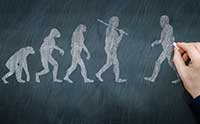Caterpillars that sign their own death warrant are a conundrum for evolution by natural selection …read more Read more here: creation.com
The paleontologist who found the crested duck-billed dinosaur was correct that preservation of soft tissue demands special conditions—in particular, rapid burial. …read more Read more here: AIG Daily
The soft-tissue fossil challenge intensified in 2013 as scientists continued to unearth remarkably preserved fossils containing young-looking, original biochemicals, cells, and tissues that defy long age assignments. More… …read more Read more here: icr.org
Cobra genome shows snake venom’s innocuous roots. …read more Read more here: AIG Daily
La Sima de los Huesos—the “Pit of Bones” in an Atapuerca cavern near Burgos in northern Spain—was the final resting place for 28 of Europe’s earliest human inhabitants, Homo heidelbergensis. …read more Read more here: AIG Daily
If a Parasaurolophus daddy sang bass, little brother was able to join right in there. …read more Read more here: AIG Daily
Evolutionists are having a difficult time deciding which animal came first: the sea sponge, comb jellies, or placozoans. …read more Read more here: AIG Daily
Supposedly half a billion years old, and yet they are fully formed! …read more Read more here: creation.com
While design is fundamental to biblical biology, there is more to the story … …read more Read more here: creation.com
Paleontologist Dr. Marcus Ross explains that God has given us many valuable clues—and more are coming to light—to help us accurately reconstruct these testaments to His creative power! …read more Read more here: AIG Daily
“Some parts are technical but a good look at the mathematical odds of evolution happening … zero.” Admin Prior to the discovery of DNA, the evidence against the theory of evolution was significant. Since the discovery of DNA the evidence against the theory of evolution has become overwhelming!! Literally, because of the discovery of DNA, the theory of evolution has become the most absurd scientific theory in the history of science!! For example, could a DVD of country music (which represents DNA) be randomly mutated into a new Rachmaninoff Piano Concerto or anything else that is useful (meaning the DNA [More]
Does the Burmese python showcase the evolution of snakes every time it swallows an enormous victim? …read more Read more here: AIG Daily
Within the biblical framework of earth history microbes, fully functioning stromatolites and even stromatolite reefs may have been created by God before Day 3 of the Creation Week. …read more Read more here: AIG Daily
They say these bugs are 100 million years old, but are they? …read more Read more here: creation.com
The popular notion that humans evolved from ape-like ancestors took several heavy hits this past year—both from secular and creation-friendly research—confirming that God created man in His image according to Genesis. Three major pillars supporting a human-chimp link crashed in 2013. More… …read more Read more here: icr.org
Have genetic discoveries broken the tie that binds us to Adam? …read more Read more here: AIG Daily
Contrary to conventional wisdom, crocodilians not only can digest fruit but seem to commonly and intentionally consume it. …read more Read more here: AIG Daily
What happens when a fig wasp fossil shows up too “soon” in the fossil record? …read more Read more here: AIG Daily
When a local fisherman hauled in a strange-looking blue fish off the South African coast, he had no clue about the significance of his find. …read more Read more here: AIG Daily
Do smart crows reveal an alternate evolutionary path to intelligence? …read more Read more here: AIG Daily
Fossil has paleobotanists puzzling over the evolutionary origin of floral pollen. …read more Read more here: AIG Daily
While neither microbes nor organic compounds have been found, researchers believe they are looking in the right place. …read more Read more here: AIG Daily
“There are many marvels of designs like this through out nature and evolutionists want us to believe they all happened by chance … give me a break!” Admin Butterfly wings are covered with tiny scales that are marvelously efficient at shedding water—so much so that they are inspiring designers interested in developing water-resistant materials. More… …read more Read more here: icr.org
Kangaroos-created or evolved? The complexity, variety and beauty of God’s creatures serve to glorify the Creator and show His power. …read more Read more here: creation.com
Scientists suggest they have solved the problem of how soft tissues like dinosaur blood vessels could have persisted for millions of years. Do their results really back up that claim? More… …read more Read more here: icr.org
These data provide a compelling alternative to old-earth and evolutionary explanations for molecular diversity, and they challenge the millions-of-years timescale common to these models. …read more Read more here: AIG Daily
Grandma Primate, What good eyes you have! “The better to see snakes,” evolutionists suggest. …read more Read more here: AIG Daily




































